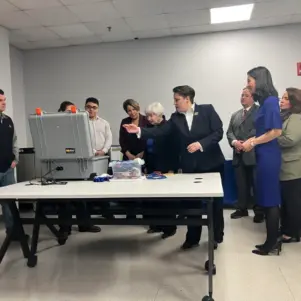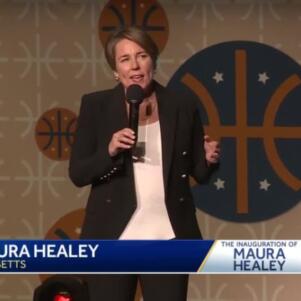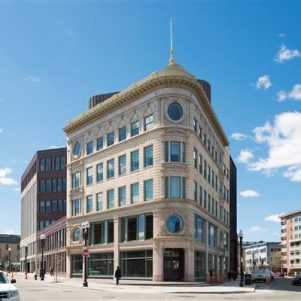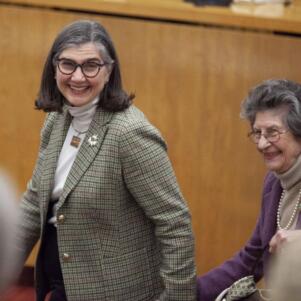Orthodox Jewish enclave faces growth, conflict
By Religion News Service | August 13, 2015, 7:45 EDT
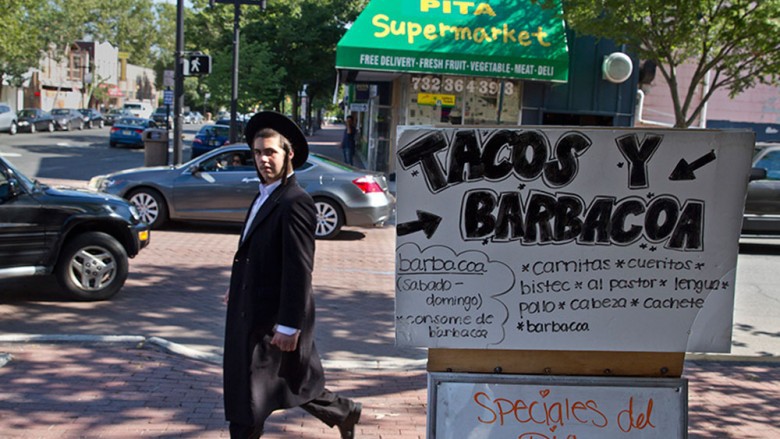 The downtown section of Clifton Avenue, rather quiet on this day, with a variety of residents. The township of Lakewood, N.J., is undergoing a population explosion. Photo courtesy of USA Today
The downtown section of Clifton Avenue, rather quiet on this day, with a variety of residents. The township of Lakewood, N.J., is undergoing a population explosion. Photo courtesy of USA Today Written by Shannon Mullen
LAKEWOOD, N.J. — Like thousands of Orthodox men here, Israel Klein came to Lakewood from Brooklyn as a young man to study the Torah at Beth Medrash Govoha, the largest yeshiva in the U.S. He eventually got married and settled here.
Lakewood offered everything a young Orthodox couple just starting out could want: good schools, affordable homes, a close-knit religious community — and opportunity.
“As Orthodox Jews we have to be near each other. We need that infrastructure,” explained Klein, now a 36-year-old father of five. “We need the synagogues. We need the schools for our children. We need the kosher groceries. … We have to have an infrastructure. So we don’t really have the option of just living anywhere.”
That infrastructure has grown enormously since he and his wife, Esther, bought their home in 2001.
If you’re thinking bagel shops and Judaica stores, think bigger. The current issue of the Lakewood Shopper, one of several flourishing weeklies, has more than 170 pages of ads for an ever-widening range of businesses that cater to the Orthodox community, from kosher Chinese restaurants and supermarkets to kitchen remodelers and travel agencies.
Only a few decades ago Lakewood was an island of urban ills surrounded by a rising tide of suburban prosperity. Today, it’s the economic engine of Ocean County.
It’s home to two universities — Georgian Court University and the BMG yeshiva; a popular minor league baseball franchise, the Lakewood BlueClaws; a medical center; a municipal airport; a bustling downtown; a regional bus station; and the second-largest industrial park in New Jersey, responsible for about 11,000 jobs.
County Planning Director David McKeon says in recent years roughly one-third of the building plans reviewed by the Ocean County Planning Board have been for projects in Lakewood.
Shaya and Sol Ilowitz are riding the wave. You see the name of their booming business, Prime Insurance Agency, on signs at construction sites all over town. As Lakewood has grown, so has their agency.
“Can’t build without insurance. Can’t get a mortgage without insurance. Can’t drive a car without insurance. You can’t have children without insurance,” said Shaya Ilowitz, 66. “Everything in the United States is built around insurance.”
Like Israel Klein, Sol Ilowitz, 37, came to Lakewood to study at Beth Medrash Govoha and decided to set down roots. He opened a branch of his family’s insurance business here in 2001. Today, the agency is opening a third Lakewood location. Twenty-five people will work there when it opens.
Esther Klein, a former IT professional, decided to get her real estate license about seven years ago in hopes of bringing in extra income to help support her growing family. Today, it’s a full-time career. About half of her clients are young Orthodox families from Brooklyn and elsewhere who are so eager to move here, they’re scooping up homes the moment they come on the market. “It’s nonstop,” said Klein, 36.
The Re/Max agency she works for is the listing agent for a pair of adjacent duplex communities under construction across from the BlueClaws’ stadium. All but a handful of the 120 units were already spoken for last week.
The duplexes — typically 3,000 square feet, with five bedrooms and 3.5 bathrooms — are in the high $400,000 range, she said. Still, Lakewood is a bargain compared with Brooklyn. There, you’d be lucky to find a two-bedroom condo for less than $500,000.
Plus, the duplexes generally have spacious basements that can be legally rented out to cover the cost of the home’s property taxes. That’s good news for new homebuyers, but bad news for traffic, since it means many single-family homes are actually multifamily dwellings.
Not everybody is celebrating Lakewood’s big surge. At the same time the Orthodox infrastructure is expanding, familiar touchstones for the non-Orthodox community are being lost. Once diverse, middle-class neighborhoods are now strung with wires suspended by poles that designate the boundaries of an eruv, an enclosed area where certain activities forbidden during the Jewish Sabbath are permitted.
For some longtime residents, the message, intentional or not, is plain: This is an Orthodox neighborhood now.
Orthodox residents now account for more than half of Lakewood’s population, community leaders estimate, though no official figures are available.
The local ShopRite shut its doors earlier this year, and a pair of large kosher supermarkets will soon fill the void. Holy Family Catholic School closed in June, due to a steep drop in enrollment.
The demographic shift hasn’t been without conflict.
Half of the 70 bias incidents reported in Ocean County in 2013 were in Lakewood, show state police data. No other town in Monmouth or Ocean counties had more than 15. Jewish residents and Orthodox-owned property are a frequent target. In June, a 46-year-old resident pleaded guilty to carving a swastika on his neighbors’ lawn.
Today, Orthodox residents occupy the majority of seats on virtually every decision-making board in town. Behind the scenes, a group of Orthodox rabbis and merchants called the Vaad helps shape the blueprint for the town, though its authority isn’t as supreme as many non-Orthodox assume.
At the same time, the changes in Lakewood have pushed the township’s black and Latino communities to the margins of the town’s civic life, community leaders say.
“We feel left out,” said the Rev. Glenn Wilson, president of Lakewood U.N.I.T.E., a local group that represents the interests of families in the township’s public school district, now overwhelmingly black and Latino.
Wilson cites his downtown dry cleaner as one small example. Now that the bulk of the business’s customer base is Orthodox, it’s closed on Saturdays and Jewish holidays “and he’s Chinese,” he said of the owner. Other businesses have made similar adjustments.
The architects of Lakewood’s growth aren’t “creating a community that’s open to other people,” Wilson said.
Meanwhile, Lakewood’s neighbors are casting a wary eye on the yeshivas, synagogues and subdivisions rising on the edges of town. Last year, residents in nearby Jackson turned out in droves to stop an Orthodox girls high school from opening there. When the proposal was rejected, Lakewood promptly made room for the school in its industrial park, already home to more than a dozen other yeshivas.
Meanwhile, other towns have taken steps to restrict where schools can be built. BMG president Rabbi Aaron Kotler thinks it’s obvious that these moves are aimed at keeping the Orthodox bottled up in Lakewood.
“When an Orthodox school or synagogue tries to open up in an adjacent town, there’s a pattern of community opposition, which is only going to magnify the growth pressures in Lakewood,” Kotler said.
Yet many Lakewood residents are just as unnerved by the fevered pace of construction going on around them. “It’s like a mad rush,” said Harold Herskowitz, 49, an Orthodox businessman who owns a toy store and yogurt shop downtown. “All of the builders are just trying to get in what they can before people wake up and realize that a town can’t function like this.”
In 2013, the Township Committee adopted a “smart growth” plan that calls for “center-based development” in new residential areas with stores, restaurants and other businesses to better contain traffic, while also upgrading roads and other infrastructure.
But that’s not how it’s playing out, Herskowitz said.
With five months still to go before year’s end, the Planning Board already has approved 491 new housing lots, seven new synagogues, two Orthodox private schools, one addition to a school and eight new commercial properties. The Zoning Board of Adjustment has been just as busy.
Tax-exempt properties owned by private schools, charities and religious institutions make up 8 percent of Lakewood’s total assessed value, according to county tax data. The ratio in Toms River, by comparison, is just 1.5 percent.
Yet property taxes in Lakewood have stayed relatively stable, compared with other towns. The owner of a home assessed at the municipal average of about $233,000 paid $5,873 in property taxes last year, a relatively modest bump from an average tax bill of $5,200 five years ago. Taxpayers in 16 of Ocean County’s 33 municipalities pay more, on average.
Meir Lichtenstein, a township committeeman, said the smart-growth plan doesn’t set a population of 220,000 as a goal; it merely quantifies the growth officials believe is coming.
“We accept it. We knew people were coming and we know people want to live here. I’d say the conscious decision that was made was we don’t want to keep people out,” Lichtenstein said.
“If people felt they wanted to move here and be part of the community, we wanted them to be able to,” he said.
Shannon Mullen reports for the Asbury Park Press, in New Jersey.



